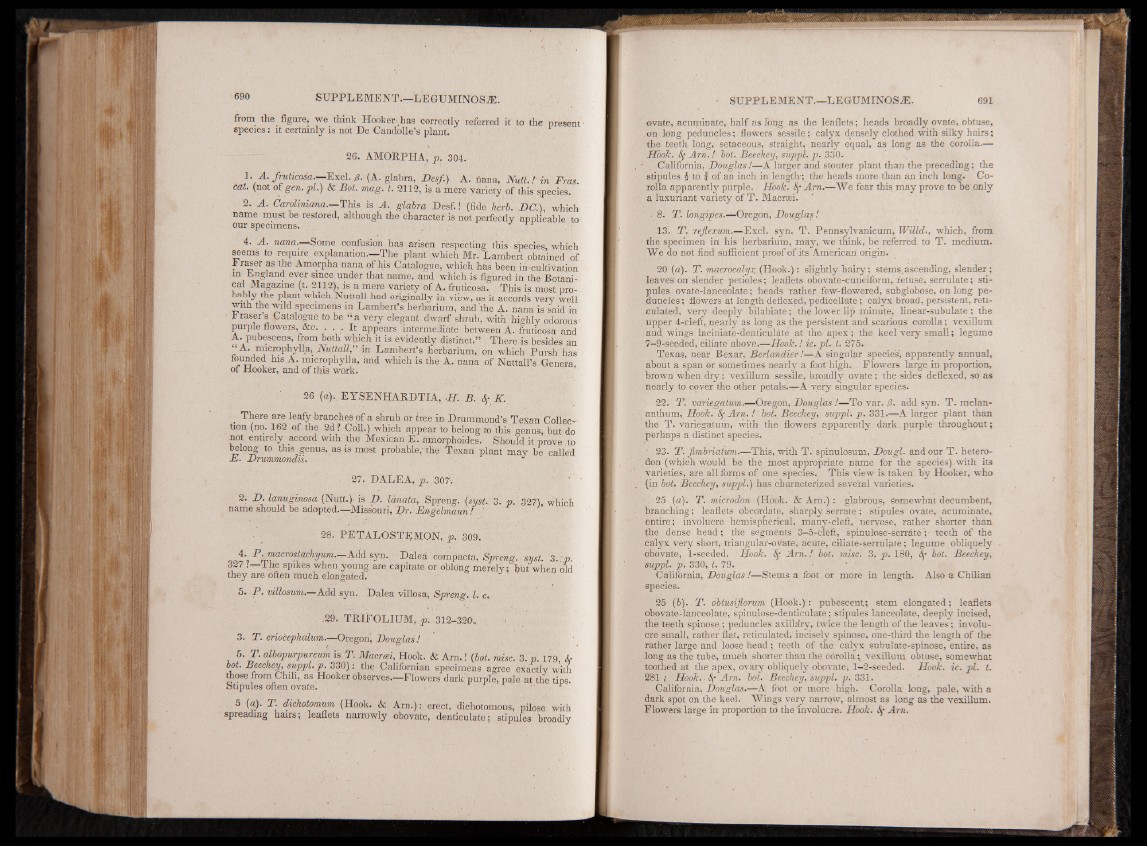
from the figure, we think Hooker , has correctly referred it to the present
species: it certainly is not De Candolle’s plant.
26. AMORPHA, V 304.
1. A. fruticosa.—Excl. 0. (A. glabra, Desf.) A. hana, Nutt. !'in Fras.
cat. (not of gen. pi.) & Bot. mag. t. 2112, is a mere variety of this species.
2. A. Caroliniana— This is A . glabra Desf.! (fide herb. DC.), which
name must be restored, although the character is not perfectly applicable to
our specimens. . , .• J 1 .
4. A. nana.—Some confusion has arisen respecting this species, which
seems to require explanation— The plant which Mr. Lambert obtained of
. raser as the Amorpha nana of his Catalogue, which has been ih-cultiVation
m England ever since under that name, and which is figured in the Botani-
» W a ,m,ere ^ P t y 'o f A. fruticosa. This is most pro-
bably the plant which, Nuttall had originally in view, as it accords very well
with the wild specimens in Lambert’s herbarium, and the A. nana is said in
k raser’s Catalogue to be “ a very elegant dwarf shrub, with highly odorous ■’
purple flowers, &c. . . . It appears intermediate between A. fruticosa and
A. pubescens, from both which it is evidently distinct;” There is besides an
“ A. microphylla, Nuttall," in Lambert’s herbarium, on which Pursh has
founded his A. microphylla, and which is the A. nana of Nuttall’s Genera
of Hooker, and of this work.
26 (a). EYSENHARDTIA, -H. B. Sf K.
. There are leafy branches of a shrub or tree in Drummond’s Texan Collec--
tion (no. 162 of the 2d ? Coll.) which appear to belong to this genus, but do
not entirely accord with the Mexican E. amorphoides. Should it prove to
belong to this genus, as is most probable,’the Texan plant may be called
E . JJrummondii. .
27. DALEA, p. 307’.
2. D. lanuginosa (Nutt.)- is D. lanata, Spreng. (syst. 3. p. 327), which
name should be adopted— Missburi, Dr. Engelmarin!
28. PETALOSTEMON, p. 309.
F-macrostacliymn,. Add syn. Dalea compacta, Spreng, sust. 3. p
3271—The spikes when.young are capitate or oblong merely; but when old
they are often much elongated.
5. P. villosum.—Add syn. Dalea villose, Spreng. I. c.
.29. TRIFOLIUM, p. 312-320.
3. T. eriocephalum— Oregon, Douglas !
5. T. albopurpureum is T. Marred, Hook. & Arn.! (lot. misc. 3. p. 179 Si-
lot. Beechey, suppl. p. 330): the Californian specimens agree exactly with
those from Chili, as Hooker observes.—Flowers dark purple, pale at the tios.
Stipules often ovate, * 5
5 (a,). T. dichotomum (Hook. & Arn.): erect, dichotomous, pilose with
spreading hairs; leaflets narrowly obovate, denticulate; stipules broadly
ovate, acuminate, half as long as the leaflets; heads broadly ovate, obtuse,
. on long peduncles; flowers sessile; calyx densely clothed with silky hairs;
the teeth long,' setaceous, straight, nearly equal, as long as the corolla.—
Hook. Sf A rn .! lot. Beechey, suppl. p . 330.
California, Douglas!—A larger and stouter plant than the preceding; the
stipules 4 to | of an inch in length-; the heads more than an inch long. Corolla
apparently purple. Hook. 8f Am.—We fear this may prove to be only
a luxuriant variety of T. Macrasi.
■ 8. T. longipes.—Oregon, Douglas!
13. T. rejlexum.—Excl. syn. T. Pennsylvanicum, Willd,, which, from
thé specimen in his herbarium, may, we think, be referred to T. medium.
We do not find sufficient proof of its American origin.
2 0(a). T. macrocalyx..(Hook.): slightly hairy; stems,ascending, slender;
leaves on slender petioles; leaflets obovate-cuneiform, retuse, serrulate; stipules
ovate-lanceolate; heads rather few-flowered, subglobose, on long peduncles;
.flowers at length deflexed,-pedicellate; calyx broad, persistent, reticulated,
very deeply bilabiate; the lower lip minute, linear-subulate; the
upper 4-cleft, nearly as long as the persistent and scarious corolla; vexillum
and wings laciniate-denticulate at the, apex ; the keel very small; legume
7-9-seeded, ciliate above.—Hook.! ic. pi. t. 275.
Texas, near Bexar, Berlandier!—A singular species, apparently annual,
about a span or sometimes nearly a foot high. . Flowers large in proportion,
brown when dry: vexillum sessile, broadly ovate; the sides deflexed, so as
nearly to cover the other petals.—A very singular species.
22. T. variegatum.—Oregon, Douglas !—To var. /?. add syn. T. melan-
anthum, Hook. Sf Arn. ! lot. Beechey, suppl. p. 331.—A larger plant than
the T. variegatum, with the flowers apparently dark. purple- throughout;
perhaps a distinct species.
■ 23. T. fimlriatwm.—This, with T.- spinulosum, Dougl. and our T. hetero-
don (which would be the most appropriate name for the species) with its
varieties, are all forms of one species. This view is taken, by Hooker, who
(in lot, Beechey, suppl.) has characterized several varieties.
25 (a). T. microd'on (Hook. & Am.) : glabrous, somewhat decumbent,
branching; leaflets obcordate, sharply serrate; stipules ovate, acuminate,
entire; involucre hemispherical, many-cleft, nervose, rather shorter than
the dense head; th’e segments 3-5-cleft, spinulose-serrate ; • teeth of the
calyx very short, triangular-ovate, acute, ciliate-serrulate; legume obliquely
obovate, 1-seeded. Hook. Sf A rn .! lot. misc. 3. p. 180, Sc lot. Beechey,
suppl. p. 330, t. 79. •
California, Douglas !—Stems a foot or more in length. Also a Chilian
species.
25 (l). T. obtusiflorum (Hook.) : pubescent; stem elongated; leaflets
obovate-lanceolate, spinulose-denticulate; stipules lanceolate, deeply incised,
the teeth spinose ; peduncles axillary, twice the length of the leaves; involucre
small, rather flat, reticulated, incisely spinose, one-third the length of the
rather large and loose head ; teeth of the calyx subulate-spinose, entire, as
long as the tube, much shorter than the corolla ;t vexillum obtuse, somewhat
toothed at the apex, ovary obliquely obovate, 1-2-seeded. Hook. ic. pi. t.
281 ; Hook. A Am. lot. Beechey, suppl. p. 331.
California, Douglas.—A foot or more high. Corolla long, pale, -with a
dark spot on the keel. Wings very narrow', almost as long as the vexillum.
Flowers large in proportion tö the involucre. Hook. Sf Am.